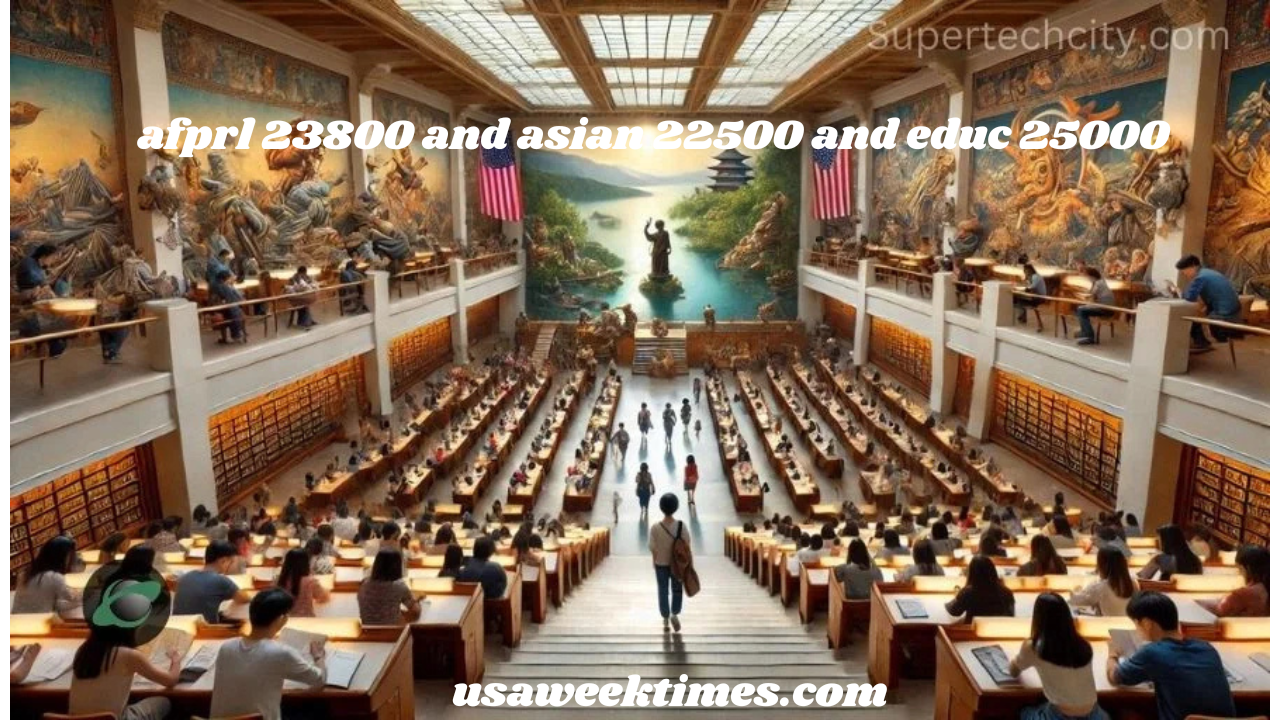Understanding AFPRL 23800 and Asian 22500 and EDUC 25000: Key Insights and Applications
In today’s competitive world, understanding the nuances of various financial and educational terms is crucial for individuals and businesses alike. Terms like AFPRL 23800, Asian 22500, and EDUC 25000 are often heard in specific sectors but may not be entirely clear to everyone. This article aims to provide an in-depth look into these terms, offering clarity on their significance and usage in various contexts. We will explore these concepts individually and discuss their relevance, particularly focusing on “AFPRL 23800 and Asian 22500 and EDUC 25000” and how they might relate to each other in different sectors.
1. What is AFPRL 23800?
AFPRL 23800 is a term often linked with specific financial or regulatory frameworks. While it may appear abstract, it is tied to a particular set of guidelines or a standardized approach used in professional or governmental sectors. AFPRL is typically associated with codes or numerical systems that help categorize different regulations or financial models. In this case, the number “23800” could represent a specific tax code, standard, or regulatory measure. This could be used in various applications such as public policy, economic planning, or fiscal management, where such numeric systems are essential to structuring different financial operations.
Moreover, AFPRL 23800 can signify a set of guidelines that professionals in the financial or legal sectors use to navigate complex rules. For instance, it could be related to a standard for analyzing financial statements, investment guidelines, or credit policies. While this term may not be commonly known in every sector, it is significant within the context of government finance or large corporate settings, where clear numerical coding helps in tracking and implementing policies.
2. Exploring Asian 22500: A Key Market Indicator
Asian 22500 refers to an index that has significant relevance in the financial markets, particularly in Asia. This number is associated with the performance of major stock indices across Asian markets, similar to how the Dow Jones Industrial Average functions in the United States. The Asian 22500 is often a benchmark for investors who want to track the growth or decline of stocks and bonds within the Asian economy. It is an essential metric for analyzing the economic health of countries in the Asian continent, ranging from Japan and China to emerging economies.
Understanding the Asian 22500 involves looking at it as a broader indicator of the performance of specific industries within the region. For businesses, particularly those operating in Asia or with substantial Asian market exposure, this index helps in making informed decisions about investment, market entry, and long-term strategic planning. It also plays a key role for policymakers, who use such indexes to guide economic decisions and forecasts.
This index is particularly useful during times of volatility in the global market, as it provides insight into the behavior of markets across diverse Asian economies. Thus, the Asian 22500 offers both a snapshot of Asia’s economic landscape and a predictive tool for future financial trends.
3. EDUC 25000: Education and Technology’s Role in Global Development
The term EDUC 25000 is directly tied to the educational sector, focusing on the broader impacts of technology and development in education. EDUC 25000 likely refers to a set of frameworks or a curriculum code used in educational systems. It could be a reference to a specific course number within a university system or a codified model for educational funding. In this context, EDUC 25000 may address global educational standards, future-ready learning techniques, and technology integration in modern classrooms.
At its core, EDUC 25000 symbolizes the evolving nature of education in a rapidly changing world. With technology playing an ever-larger role, such initiatives aim to equip students with the tools, knowledge, and mindset needed to succeed in an interconnected, fast-moving global environment. This code may also be used to describe specific grants, funds, or scholarship programs aimed at advancing educational opportunities for students in underserved areas.
For instance, EDUC 25000 could be tied to governmental or international efforts to promote education in countries where access to learning is limited. By creating frameworks that fund educational initiatives, it helps ensure that the next generation has the skills necessary for contributing to technological, economic, and social advancements.
4. The Intersection of AFPRL 23800, Asian 22500, and EDUC 25000
While AFPRL 23800, Asian 22500, and EDUC 25000 may initially seem unrelated, there are some interesting intersections where they could converge. For instance, businesses and governments could use financial models like AFPRL 23800 to allocate resources to educational initiatives that fall under frameworks like EDUC 25000. Similarly, economic stability reflected in indices like Asian 22500 could influence funding and policy decisions related to both education and finance.
A country experiencing growth, as seen through the Asian 22500, may have more resources available for investing in its education system. This could lead to the development of new educational programs, technological tools, or infrastructure projects that align with global standards in EDUC 25000. Furthermore, countries or organizations may use financial codes like AFPRL 23800 to structure how funds are allocated to educational projects in specific regions or sectors.
Thus, while these three codes or terms exist in different sectors, their impact on one another is undeniable. Financial frameworks influence how educational projects are funded, while strong economic performance enables greater investment in public and private sector education initiatives.
5. Practical Applications of AFPRL 23800, Asian 22500, and EDUC 25000
The practical application of these terms can be seen in a variety of real-world situations. A government might utilize AFPRL 23800 to set tax codes or financial policies that ensure the economic stability reflected by the Asian 22500 index. With a solid economic foundation, the country may then allocate funds toward educational reforms or programs following the EDUC 25000 framework, thus creating a cycle of growth that benefits all sectors.
For businesses and investors, understanding these codes provides insight into how global markets operate. By monitoring the Asian 22500 index, they can make more informed decisions about investment, understanding which regions or sectors are poised for growth. Similarly, educational leaders can use the insights from financial models like AFPRL 23800 to advocate for the necessary funding to support new educational projects, aligning them with the most pressing economic trends.
Conclusion
In summary, “AFPRL 23800 and Asian 22500 and EDUC 25000” represent critical pillars in the worlds of finance and education. Each code or index plays a distinct but complementary role in shaping policy, growth, and development in various sectors. By understanding the relationship between these terms, we can better navigate the complexities of modern governance, investment, and educational reform. Together, these frameworks offer a clearer vision of the interconnected world in which we live, helping guide both immediate and long-term decisions across industries.

![1-4: creating a masterpiece [15 marks]](https://usaweektimes.com/wp-content/uploads/2025/01/1-4-creating-a-masterpiece-15-marks-390x220.png)


